| The previous two pages show the Canadian Parliament.
This page contains all the other things we saw in Ottawa. The information
centre in Ottawa is a good place to start. In the entrance is a huge table
with a model of the central city. This is just a small section showing
Parliament square (copper coloured) and the river. It has little lights to
show you where the main tourist attractions are. |  |
 |
An odd thing to take a photo of, but this is the largest slide-out I think
we have ever seen. It is on a 53ft trailer and belongs to the control van
for Radio Canada. It was parked behind the Parliament buildings and was
presumably covering the Canada Day celebrations. I'm not sure they don't
support TV as well since there were certainly cameras there and there
weren't any other control vans. |
| The sound stage was quite large with dancing figures
back-projected onto a gauze screen behind. Various groups were setting
up and practising. Some were not bad folk/country artists although we hadn't
heard of any of the names on the bill. | 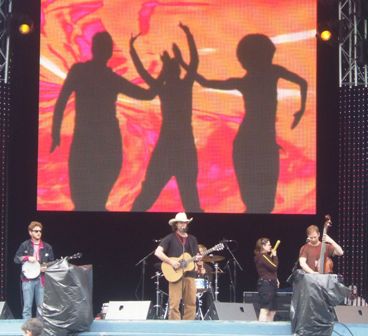 |
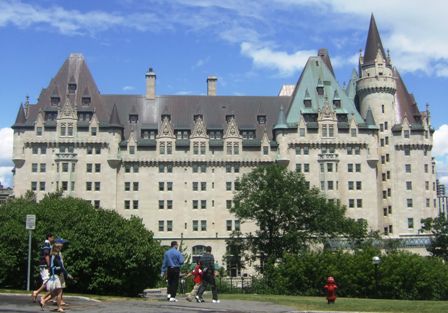 |
Impressive as it may be, it is actually only a hotel. This is the Chateau
Laurier. Built between 1908 and 1912 by the Grand Trunk railway it was the
residence of prime minister R B Bennett from 1930 to 1935. Most of the
really impressive hotels in Canada were built by the railroads which were
absolutely instrumental in the development of the country. The railways were
funded by the government selling the land on either side of the tracks to
immigrants for development. |
| There is a huge catholic cathedral (Notre Dame) with
silvery towers (very common in Canada). We didn't go in because there was a
wedding in progress, hence the stretched limousine outside (there were in
fact two). It faces west over the parliament buildings, the park and the
river. |  |
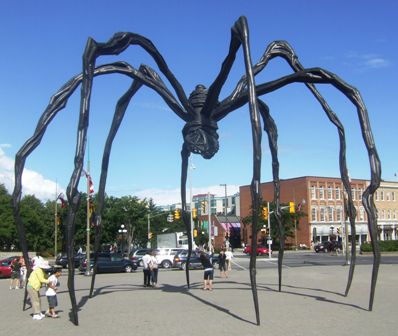 |
Ottawa is very much a city of the arts, particularly sculpture. This
unusual bronze spider is outside the National Gallery of Canada just across the road
from the cathedral. Apart from being a spider, we have no idea of its
relevance. |
| This is 'embassy road'. We found the Pakistan embassy,
small and rather tired looking, the Kuwaiti embassy, very modern and stylish
and looking like it cost plenty of money. This is the US embassy, with an
inner concrete wall, an outer steel fence, steel bollards and then concrete
blocks. Why are they so much more paranoid than any other country in the
world? It seems odd in Canada where the Parliament buildings and the mint
almost have open access. | 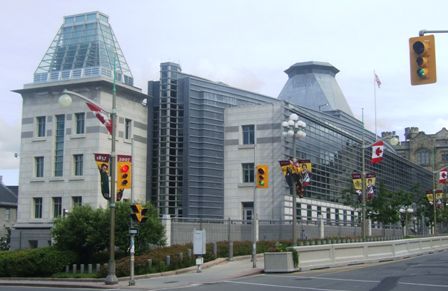 |
 |
Impressive though it may look with the columns and everything, this is also
just
another city centre hotel. The flags flying outside are those from each of
the Canadian provinces. |
| It may look like a London bus but is it? We have
seen a lot of tourist buses on our travels, usually red in colour, which
look just like the various models of London bus, but some of them have never
been on the streets of London as they have the driver's seat and doors or
rear open platform on the wrong side. |  |
 |
More sculptures in the park at the side of the Rideau canal. These are also
modern in style and unusually they have been painted. The faces looked
rather ethnic in style perhaps reflecting the Indian/French mixed race Metis
population. |
|
The Rideau canal runs from the centre of Ottawa for 202km to Kingston on
Lake Ontario and is regarded as a major engineering marvel of the 19th
century. Built between 1826 and 1832 under the direction of Colonel John By
of the Royal Engineers, it was designed to enable troops to be moved without
having to pass American guns on the St Lawrence river. It starts with this
rise of eight locks which raise the boats 79ft. from the Ottawa River. The
building on the left at the bottom is the Commissariat built in 1827 to
store supplies for the canal, it is the oldest stone building in Ottawa and
today houses a museum on the canal. In 2007 it was designated as the 14th
World heritage site in Canada. | 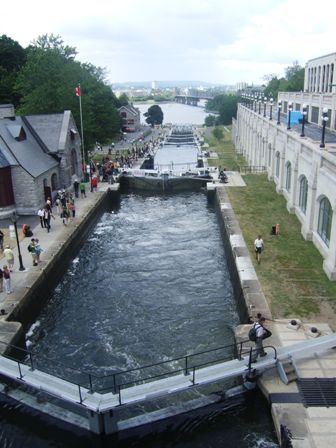 |
 | A flag for each Canadian province from Quebec, which
on its own would be the 19th largest country in the world, through Prince
Edward Island which must be one of the smallest to Nunavut which only
obtained provincial status in 1996. That must have complicated a number of
public monuments such as this. |
|
We did pass through this farmers' market in the city centre and were surprised by the artistic displays
and the varieties of fruit and vegetables on offer. It all seemed very neat and tidy. |  |
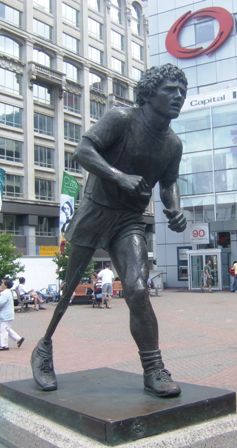 | And a statue of a private individual. Terry Fox
(1958-81) was a
young man who was stricken with bone cancer and set out to walk across
Canada in a 'Marathon of Hope' (3400 miles) to raise money for cancer research. He only made it
halfway (St Johns, Newfoundland to Thunder Bay 5373km) before his cancer
defeated him, but he earned a place in the history books and became a worldwide
inspirational icon and role model. |
|